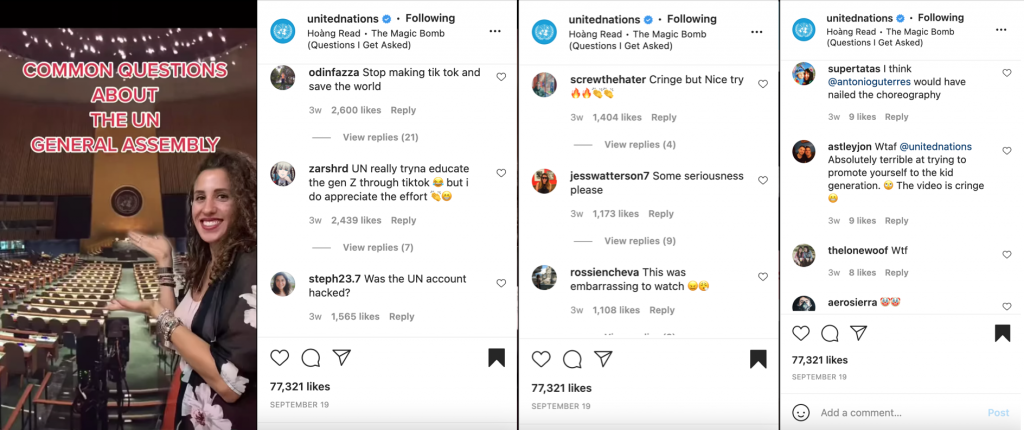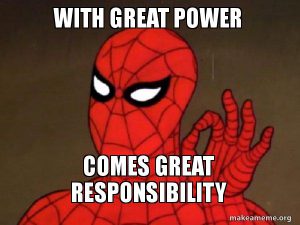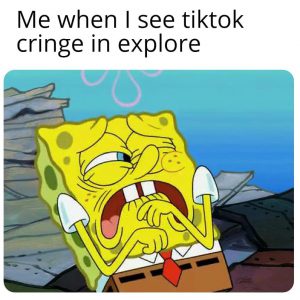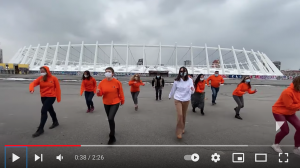In my last post I discussed online communication and introduced the UNGA dance as an example of communication on social media. I will now follow up on it, analysing the web reactions to the campaign and broadening the discussion with the comments received.
UNGA Reactions
These below are some reactions to the United Nations General Assembly dance collected from the web.

As hilarious as the comments look, I doubt they resemble what the UN wanted to achieve with the experiment (😂).

Not only we can argue that the general response from the web was far from positive, but also that the campaign ultimately reinforces wrong stereotypes. Perhaps not directly, but let’s have a look at that top comment: “stop making tik tok and save the world”.
Given the element of irony in the comment, we can still argue that some people might believe that the UN’s job is to save the world. That sure sounds like a lot of responsibility, UN!
It also ferments long-lived debates in the developing sector that have been hotly disputed for years.
Regarding development, early C4D practitioners like Fraser and Restrepo-Estrada were already arguing more than 20 years ago how this:
“should originate from that society’s values and its perceptions of its own future. It should be as self-reliant as possible, in that each society should draw on its own resources and strengths to the maximum practical extent before using external resources.”
McAnany also argues that the dependency paradigm no longer finds place in modern communication for development approaches, where a more participatory paradigm is nowadays broadly adopted.
What is the purpose?
In the UNGA dance post’s comment section, Lauren, one of our readers, asks:
“I wonder really what the purpose was for the UNGA, who it reached,
and if it really had any effect on educating people about the purpose of the general assembly.”

Reaching and educating young audiences was most likely the purpose of the UNGA dance.
I believe the initiative was an attempt to connect with a target audience that is often far from what the UN do, and is not much captivated by how the UN engage with them.
However, did they try a bit too hard, looking lame instead?
SpongeBob’s reaction seems to express the general feeling of many people out there.
Jerusalema
Lauren brings to our attention another interesting online phenomenon: Jerulasema, a South African dance that went viral in 2020 with the #JerusalemaChallenge. The challenge reached local communities around the world and was welcomed and embraced by the UN as well.
The reason behind the UN’s affiliation with the dance challenge is connected to the SustainableDevelopment Goals. The Global Goal 3 aims to ensure healthy lives and promote well-being for all at all ages. It’s evident how an initiative like Jerusalema communicates these values, conveying a positive message, specially in times of pandemic.
The dance challenge was already viral, though. Was the UN decision of jumping on the #JerusalemaChallenge hype train so necessary to further the message? Or was it more related to a self-promotion aspect?
The underlying threat
Online communication seems to comprise a threatening feature: obsession. The obsession of being present on every platform, of rating first, of reaching everyone. Will “at any cost” soon enter the list too?
Online communication is, after all, the mirror of the capitalistic society that generates it, where competition is at its very core. It’s simply marketing. Be there, be first, be better. There is nothing wrong with that (maybe?) as long as the “how” stays out of the equation. When the quality of what we do and want to communicate is effected by this obsession and we lose control of the game, we also risk to lose purpose and compromise ethics.
In the comments, our readers agree that being on every platform and reaching everybody is utterly unnecessary. Contents matter more. Quality over quantity. And if you ask how to achieve that, I once again go back to our readers and quote Mercy:
“The heart dictates”
Reference material:
Fraser, C., and Restrepo-Estrada, S. (1998). Communicating for Development: Human Change for Survival. London and New York: I. B. Tauris.
Globalgoals. (2021) Global goal 3: good health and well-being. Retrieved from globalgoals.org https://www.globalgoals.org/3-good-health-and-well-being
McAnany, Emile G. (2012). Saving the World : A Brief History of Communication for Development and Social Change, Champaign, IL: University of Illinois Press.
Mlaba, K. (2020, November 11). Discover the South African ‘Jerusalema’ Dance Challenge. Retrieved from globalcitizen.org. https://www.globalcitizen.org/en/content/jerusalema-south-africa-dance-craze-covid-19/
Timesnownews. (2021, September 21) ‘Cringe Personified’: United Nations jump into the ‘Questions I asked’ TikTok trend bandwagon, video gets flak. Retrieved from timesnownews.com. https://www.timesnownews.com/the-buzz/article/united-nations-uses-tiktok-trend-questions-i-asked-in-viral-video-gets-flak/816084
UNFPA Ukraine. (2021, April 1). Jerusalema Dance Challenge | United Nations Population Fund in Ukraine Retrieved from Youtube.com https://www.youtube.com/watch?v=6wM06GHpEeY



